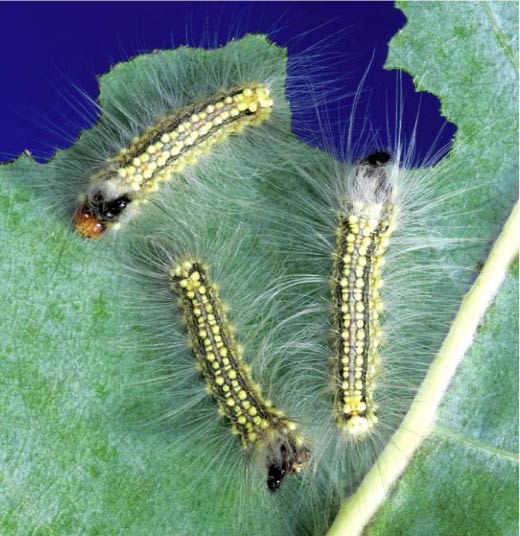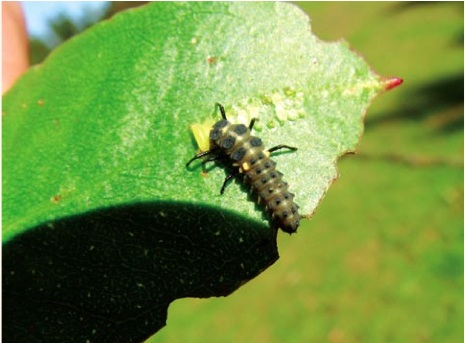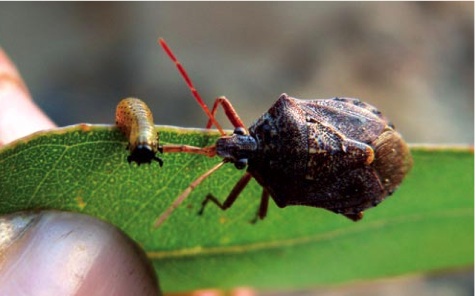Health issues with eucalypts
Denis Hocking, New Zealand Tree Grower November 2006.
Health issues with eucalypts fall into three main categories – insect pests, foliar disease and root diseases caused by fungi and Phytophthora species. While insect pests tend to get the publicity, the other diseases need to be considered when selecting species and siting eucalypts.
Different species vary greatly in their susceptibility to insect pests and diseases and these susceptibilities tend to parallel the accepted taxonomic divisions of the Eucalyptus genus. The genus is divided into seven sub-genera, with an eighth subgenus Corymbia now accepted as a separate genus but still commonly regarded as gums. Other closely related genera including Lophostemon and Angophora share some of Eucalyptus insect pest and disease problems.
Subgenus Symphyomyrtus the biggest
Of the seven Eucalyptus subgenera, two are particularly important in New Zealand forestry. Symphyomyrtus is the biggest with around 500 of the 700 or so Eucalyptus species, including many that are very common in New Zealand such as E. nitens, E. saligna and E.botryoides.
As a general, but not universal rule, Symphyomyrtus species suffer from many more insect pests in their natural habitats, and have suffered much more severely from insect attack in New Zealand. In addition, possums seem to find Symphyomyrtus species more palatable.
On the other hand, Symphyomyrtus eucalypts generally suffer less from root diseases and tolerate wetter, higher organic soils. Indeed, they normally require more fertile sites. There are exceptions to these generalisations. For instance E. cladocalyx, a Sympyomyrtus species, though well separated from other species in the subgenus, is remarkably free of insect pests and tolerates poor soils.
The monocalypts
The other big subgenus, with around 130 species is Monocalyptus and commonly known as the monocalypts. In turn, the monocalypts are made up of three major and several minor groupings.
The ash group including for example E. fastigata, E. obliqua and E. regnans, is common in New Zealand. The stringybark group including E. muelleriana, E. globoidea, E. laevopinea with E. pilularis very closely related, is gaining increasing favour on account of health, performance, milling and timber properties. The peppermint group includes some relatively common ornamental and shelter species such as E. pulchella. As a general rule, the monocalypts have fewer serious insect pests, are less troubled by possums, but are more susceptible to root diseases, than Symphyomyrtus species. Interestingly, the monocalypts are more drought susceptible than many Symphyomyrtus species.
Some of the rest
Amongst the other subgenera, Nothocalyptus includes only one species, E. microcorys or tallowwood, but this is an excellent timber species now gaining favour in warmer parts of New Zealand. In addition, E. microcorys is remarkably free of insect pests and diseases in New Zealand and in its natural range in Australia.
The Corymbia genus includes the useful plantation species C. maculata and the popular ornamental C. ficifolia. Corymbia species seem to be comparable to Symphyomyrtus species with regard to the risk of insect pests and are generally even more resistant to pathogenic soil organisms, but a number of species are adapted to poor, infertile soils. Most Corymbia species occur in tropical or sub-tropical Australia with C. maculata and C. gummifera extending down the New South Wales coast.
Risks vary
The point to be understood here is that the risk of insect pests and root diseases vary amongst species, as does the risk of foliar, fungal diseases in a somewhat different fashion. These risk factors need to be considered alongside other site characteristics such as frosting, fertility, drought risk, exposure especially to coastal, saline wind, when selecting eucalypt species that will maximise the chance of success and minimise the risk of failure.
Insect pests of eucalypts

For those interested in insect pests of eucalypts in New Zealand, the best reference is probably Colonisation of Eucalypts in New Zealand by Australian Insects, by TM Withers, in Australian Ecology 2001volume 26. This information has been seriously plagiarised for this article. Information covering eucalypt pests and diseases is found on the NZFFA website.
It has been estimated that there may be 15,000 to 20,000 species of insects feeding on eucalypts in Australia. These include both specialists restricted to a small number of eucalypt species, and generalists that are much more catholic in their tastes and feed on species from several genera.
Chewing, sucking and gall forming insects
To date around 30 specialist eucalypt, insect pests have established in New Zealand, including at least three – Uraba lugens or gum leaf skeletoniser, Creiis litturatus and Anoeconeoassa communis – since Wither’s paper was published in 2001. They are mainly defoliators, with chewing mouth parts, sap sucking psyllids, lerps and scale insects and a couple of gall forming insects. In addition, another 31 Australian, phytophagus insects known to feed on eucalypts have arrived in New Zealand and a few, New Zealand insect species make limited forays on to eucalypts.
Certain eucalypt species have been especially popular with these insects. In particular, E. botryoides, E. saligna, E. globulus, E. nitens and some related species have been especially hard hit. Other species and groups have been relatively unaffected by insect pests present in New Zealand.

In their natural environment these insect pests are attacked and often very effectively controlled by specialised parasitoids, mainly small wasps, and more generalist predators such as ladybirds and lacewings. But there is more. The parasitoids in turn can be attacked by hyper-parasites, even smaller wasps that lay their eggs in the already parasitised eggs, larvae or pupae of the original pest. It is entomology on steroids, and hyper-parasites have seriously compromised the biocontrol of two serious eucalypt pests in New Zealand – Paropsis charybdis and Cardiaspina fiscella.
Control not always practical
Eucalypts have evolved in the presence of this plethora of insect parasites, parasitoids, predators and hyper-parasites and have adapted accordingly. Many insect pests have periodic, epidemic cycles in which there can be widespread damage to certain eucalypt species over quite wide areas. The trees have adapted and are capable of recovering from virtually total defoliation. However repeated attacks will slow growth rates and may kill some trees.
The problem in New Zealand is that insect pests tend to arrive without their biological control agents and this means they may be more destructive here than they are in Australia. For example Paropsis charybdis and Ophelimus eucalyptii are minor and rare pests respectively in Australia, but are very serious pests in New Zealand.
It is normally not practical to try and control insect attack on eucalypt trees, but foliage browsers can be sprayed with an appropriate insecticide such as Btk, pyrethroids or organophosphates. Sap suckers and leaf miners are difficult to reach with such spraying. Larger plantations have been aerially sprayed but it is expensive, can be environmentally risky, and protection will only last for a few months at best. Large caterpillars such as Opodiphthera eucalypti, Emporer gum moth, can be physically plucked off small trees.

If you have a particularly valuable specimen tree it might be worth considering stem injection with an appropriate insecticide. This technology is still being developed by Scion, HortResearch and others.
The most successful means of controlling eucalypt insect pests in New Zealand has been the controlled introduction of parasitoids, chiefly small wasps that target one or just a few insect pests. However such introductions are expensive. Captive breeding in quarantine facilities and host testing to ensure the parasitoid will not attack indigenous or beneficial insects, can be technically very demanding.
Plant the right eucalypts
For a grower, the best means of defence is to avoid planting very susceptible or high risk species of eucalypts and to plant the appropriate species for the site to ensure good health and vigour. We need a lot more information to help in risk assessment, in particular the relative risk to different eucalypt species that still lurks on the far side of the Tasman, and the likely future damage of the latest, and potentially one of the most destructive insect pests, Uraba lugens or gum leaf skeletoniser. However we can make some generalisations.
A full list and description of insect pests of eucalypts in New Zealand is not feasible here as it would fill the whole magazine, but information is available on the
Root diseases of eucalypts
As mentioned above, the different subgenera of Eucalyptus show different patterns of susceptibility to attack by soil pathogens. As a general rule, the monocalypts, being species of the lower fertility, low organic and free draining soils are much more susceptible to soil pathogens than the Symphyomyrtus species which tend to favour the more fertile, higher organic soils. Although Symphyomyrtus species extend into much drier environments than any monocalypts, it is Symphyomyrtus species that occupy wet, or seasonally wet, sites. Corymbia species are generally very resistant to pathogenic soil fungi.
In New Zealand certain of the ash group eucalypts, in particular E. fraxinoides and E. delegatensis, have proved very susceptible to root diseases, especially on wetter sites. Other ash and stringybark eucalypts appear less susceptible but are still at risk and need to be sited on free draining soils. Amongst soil pathogens, eucalypts appear to be most susceptible to Phytophthora root rots, in particular P. cinnamomi. Compared to radiata pine, eucalypts are reasonably resistant to Armillaria species, and show varying susceptibility to other soil borne fungi. The best reference for these soil borne diseases is the Forest Research Bulletin 220, An Introduction to Diseases of Forest and Amenity Trees in New Zealand by G S Ridley and M A Dick.
The Phytophthora genus includes more than 70 species globally and these are common soil organisms in wetter and heavier soils. They are not fungi, being more closely related to certain algae, but are armed with a very formidable array of plant toxins and attack enzymes. Normally the first sign of disease will be a rapid browning of part of, or all the canopy followed by rapid death.
There is little that can be done to treat soil borne disease apart from species and site selection and matching. Avoid planting ash and stringybark eucalypts on permanently or seasonally wet sites and be especially careful with E. fraxinoides and E. delegatensis.
Foliar diseases of eucalypts
Whereas both insect pest host preferences and susceptibility to root fungal diseases can be related to the taxonomic position of eucalypts, foliar diseases tend to relate more closely to the climatic environment in which the species originated. The common leaf spot fungi will attack a wide range of species from all major sub-genera.
Avoid summer dry to summer wet
As a general rule, foliar diseases are worse when eucalypts from summer dry ranges are grown in warmer, humid, summer wet areas. In very broad terms, areas of eastern Australia south of Sydney have a more Mediterranean climate with, on average, higher winter and lower summer rainfall. Areas north of Sydney trend from a uniform to a markedly monsoonal and tropical climate with much higher summer rainfall. South Australia and West Australia, apart from the tropical north, are markedly Mediterranean. Annual rainfall and average humidity is generally significantly higher in the south eastern mountains, western Tasmania, the south western corner of West Australia and along the eastern coast.
While moving summer dry species into warmer, summer wet areas tends to result in serious foliage health problems, eucalypts from summer wet areas of Australia generally tolerate, even thrive, in the winter wet and summer dry conditions commonly found in eastern New Zealand.
Most are forest species
Most of the preferred eucalypt species grown for timber in New Zealand are forest species, either closed or open forest, from the moister areas of south eastern Australia. Nevertheless, foliage disease problems exacerbated by higher summer rainfall are recognised problems. Therefore, extensive defoliation of E. regnans and to a lesser extent, E. delegatensis – species from southern winter rainfall areas – was recorded in the Kinleith Forests after wet spring and summers in the late 1980s and became known as Barron Road syndrome. E. fastigata, a somewhat more northern species from areas with relatively uniform rainfall distribution was little affected. A suite of foliar fungi were responsible with Aulographina eucalyptii a major player.
Similarly, E. nitens has suffered badly from leaf spot fungi in warmer, humid areas such as lower altitude Bay of Plenty forests, while being little affected in higher altitude and more southern, cooler areas. It has also been my observation that stringybark eucalypts, generally species from the summer dry areas, look decidedly healthier in summer dry areas than they often appear in parts of Northland and Bay of Plenty.
Identifying the particular fungi causing leaf spot in any eucalypt can be difficult and generally requires an expert. Several fungi can be present and all may look superficially similar. The most easily identified is probably Phaeophleospora eucalypti, formerly Septoria pulcherrima, with pale yellow blotches turning to a bright carmine red colour.
Again Forest Research Bulletin 220 is a very useful reference.
General recommendations
The healthiest eucalypt in New Zealand is undoubtedly E. microcorys, with essentially zero insect pest problems and few, if any, foliar or root disease problems. However it does require warmer, frost-free sites and is comparatively slow growing.
On free draining, summer dry, warmer sites, the stringybark eucalypts are very healthy, and the more frost tolerant E. laevopinea and E. youmanii will extend the range. While they currently have few insect pests, hot humid summers can lead to foliar disease. E. pilularis is better suited to humid summers. Uraba lugens, gum leaf skeletoniser may be a future threat.
The ash group eucalypts currently have few insect pests, and are more cold tolerant than the stringybarks, but can be susceptible to root and foliar diseases. E. fastigata and E. obliqua are probably the best bets, but again, Uraba lugens may be a future threat.
While the Symphyomyrtus species are generally more tolerant of wet or seasonally wet sites, many are susceptible to a variety of insects pests. Species need to be assessed individually with some continuing to show minimal health problems, such as E. cladocalyx, while others, such as E. botryoides may well be in terminal decline.
If you are in Northland, Coromandel, Bay of Plenty, with regular, warm, wet summers, be cautious about planting species from the summer dry and cooler, higher altitude areas of Victoria, South Australia and Western Australia.
Thanks to Margaret Dick and Diane Jones from Scion, and Dean Satchell for assistance and for some of the photos.

 Farm Forestry New Zealand
Farm Forestry New Zealand

